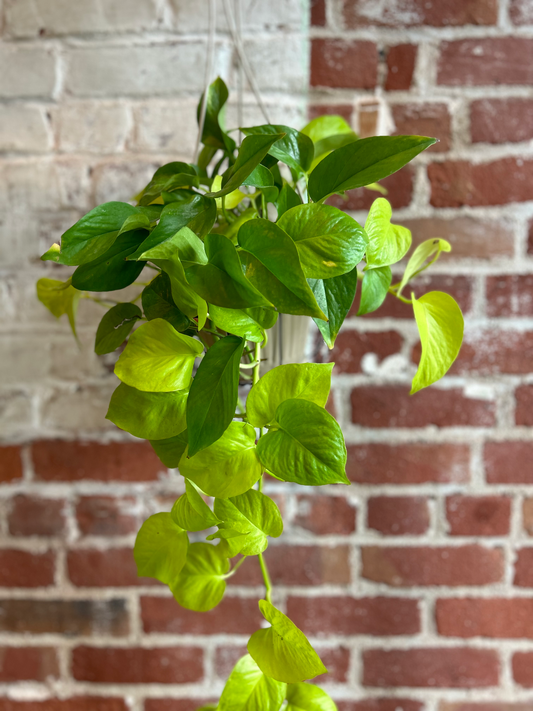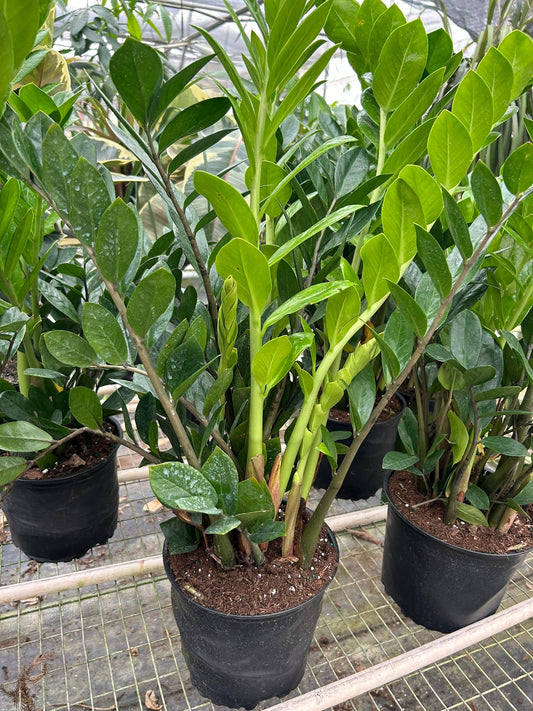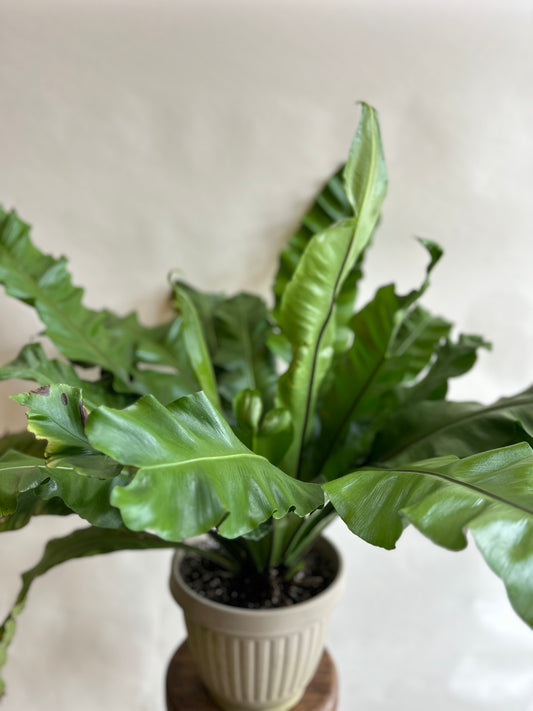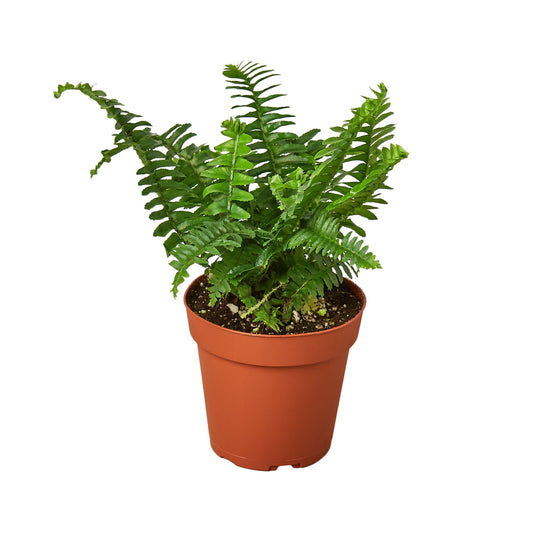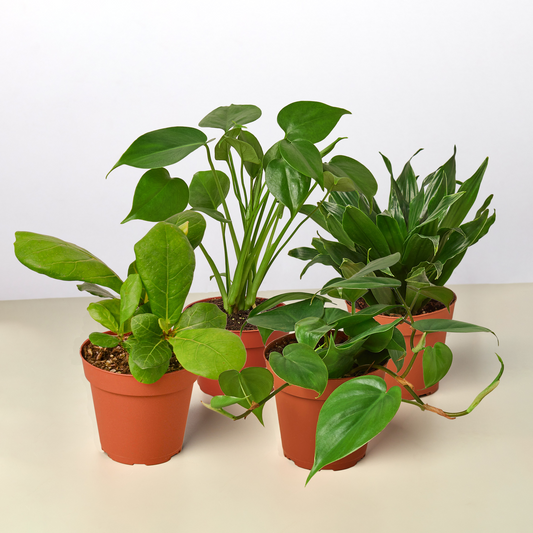Are Whale Fin Snake Plants Toxic to Cats?
Cafe Planta Team
Whale Fin Snake Plants, or Sansevieria masoniana, have become quite the darling of the plant world with their strikingly unique appearance. But as captivating as they are, many pet owners are left wondering: are these plants safe for our feline friends? It’s a crucial question for any cat parent who’s also nurturing a love for houseplants.
This article delves into the nitty-gritty of Whale Fin Snake Plants and their relationship with cats. We’ll cover everything from their toxicity and symptoms of ingestion to tips for keeping both your plants and pets happy and healthy in your home. By the end, you’ll be well-equipped to create a pet-friendly and plant-filled environment.
Understanding Whale Fin Snake Plants
Let’s start by getting to know the star of the show: the Whale Fin Snake Plant. These plants are a species of the Sansevieria family, known for their broad, paddle-like leaves that can grow impressively large, resembling a whale’s fin—hence the name. They’re not just a pretty face, though. These plants are incredibly hardy, making them a favorite for plant people who might not have the greenest thumb.
One of the key reasons Whale Fin Snake Plants are so popular is their low-maintenance nature. They thrive on neglect, requiring minimal watering and doing well in a range of lighting conditions. Whether you place them in bright, indirect light or a shadier corner, they tend to adapt quite well. Plus, they’re great air purifiers, known for their ability to filter out toxins from the air. It’s no wonder they’re a staple in many homes.
However, as beautiful and beneficial as they are, there’s a significant consideration for pet owners: their potential toxicity to cats. This brings us to the main concern at hand—are these plants safe around our curious, four-legged companions?
Are Whale Fin Snake Plants Toxic to Cats?
Yes, Whale Fin Snake Plants are toxic to cats. Like other members of the Sansevieria family, they contain saponins, which are chemical compounds that can cause adverse reactions in pets when ingested. While these plants aren’t lethally toxic, they can make your cat feel pretty uncomfortable.
When a cat chews on or ingests parts of a Whale Fin Snake Plant, they might experience symptoms such as:
- Vomiting
- Nausea
- Diarrhea
- Excessive drooling
- Stomach upset
It’s important to note that the severity of these symptoms can vary depending on how much of the plant your cat has consumed. In most cases, the symptoms are mild and can be managed at home. However, if your cat shows severe symptoms or if you’re unsure, it’s always best to consult a veterinarian.
Recognizing Symptoms of Plant Poisoning in Cats
Cats are naturally curious creatures, and they often rely on their mouths to explore the world around them. This can lead to them nibbling on houseplants, including those that aren’t the safest options. As a cat parent, it’s important to recognize the symptoms of plant poisoning, so you can act quickly and ensure your furry friend’s well-being.
Here are some common signs that your cat may have ingested a toxic plant:
- Gastrointestinal distress: This includes vomiting, diarrhea, and loss of appetite. If your cat suddenly stops eating or starts throwing up after being around your plants, it’s time to investigate further.
- Drooling or foaming at the mouth: Excessive drooling or foaming can be a reaction to irritation in the mouth and throat caused by the plant’s saponins.
- Lethargy: A poisoned cat may become unusually tired or weak. If your normally active cat is suddenly sluggish, keep a close eye on them.
- Changes in behavior: Irritability, restlessness, or signs of pain when touched are red flags that something might be wrong.
If you notice any of these symptoms and suspect your cat has ingested part of a Whale Fin Snake Plant, it’s best to consult your veterinarian. They can provide guidance on how to best care for your cat and whether treatment is necessary.
Creating a Cat-Friendly Plant Environment
Now that we’ve established the potential risks of having Whale Fin Snake Plants around cats, let’s talk about creating a space where both your plants and pets can coexist harmoniously. It’s all about strategic planning and a little creativity.
Here are some tips to keep both your cats and plants happy:
- Placement is key: Place your Whale Fin Snake Plant in areas that are hard for your cat to reach. High shelves or hanging planters can be a good option. Make sure the spot still receives adequate light for the plant to thrive.
- Cat deterrents: Use pet-safe deterrent sprays on your plants. Cats generally dislike citrus smells, so a homemade spray with water and a few drops of citrus essential oil can be effective.
- Alternative options: Provide your cat with safe plants to chew on, like cat grass or catnip. This can distract them from your more precious, albeit toxic, plants.
- Training: Sometimes, a little training can go a long way. Use positive reinforcement to teach your cat to stay away from plants. Reward them with treats when they ignore the plants.
By taking these steps, you can enjoy the beauty of your Whale Fin Snake Plant without worrying too much about your cat’s curiosity getting the better of them.
Alternatives to Whale Fin Snake Plants
If the idea of having a potentially toxic plant in your home doesn’t sit well with you, consider some pet-friendly alternatives. There are plenty of beautiful plants that can coexist peacefully with your furry friends.
Here are a few safe options for cat-loving plant people:
- Spider Plant (Chlorophytum comosum): These are non-toxic to cats and have a lively, grassy appearance. They’re easy to care for and look great in hanging baskets.
- Bamboo Palm (Chamaedorea seifrizii): Known for their air-purifying qualities, bamboo palms are safe for cats and add a tropical touch to your space.
- Boston Fern (Nephrolepis exaltata): These lush, green ferns are non-toxic and thrive in indirect light and high humidity.
- Areca Palm (Dypsis lutescens): Another safe option, areca palms are elegant and can grow quite tall, making them a striking addition to any room.
With these alternatives, you can create a lush, vibrant home without compromising your cat’s safety. Plus, you’ll still have plenty of options to express your personal style and love for plants.
How to Introduce New Plants to a Home with Cats
Bringing a new plant into a home with cats requires a bit of strategy to ensure a smooth transition. Cats are creatures of habit, and anything new in their environment can pique their curiosity. Here’s how you can introduce new plants without causing chaos:
1. Start slow: Gradually introduce the plant to your home. Place it in a room where your cat doesn’t spend much time, and let them discover it at their own pace.
2. Monitor interactions: Keep an eye on your cat’s behavior around the new plant. Are they interested or indifferent? Does the plant seem to attract their attention? Monitoring helps you gauge whether further precautions are necessary.
3. Create boundaries: Use barriers or plant stands to make it more challenging for your cat to access the plant. This can be particularly useful if your cat is prone to chewing or knocking over plants.
4. Positive reinforcement: Reward your cat when they ignore the plant or show disinterest. Positive reinforcement can help them learn that the plant isn’t worth exploring.
By taking a thoughtful approach, you can add to your plant collection without disrupting your cat’s routine or safety.
Managing Accidental Ingestion
Despite our best efforts, accidents happen. If your cat does manage to munch on a Whale Fin Snake Plant, don’t panic. Here’s what you can do:
- Assess the situation: Determine how much of the plant your cat has ingested and monitor their symptoms closely.
- Contact your vet: Reach out to your veterinarian for advice. They’ll provide guidance based on your cat’s symptoms and the amount of plant ingested.
- Keep them comfortable: Ensure your cat has plenty of water and a comfortable place to rest. Sometimes, a calm environment can help them recover more quickly.
- Prevent future incidents: Learn from the experience and adjust your plant placement or deterrent strategies as needed.
While it can be stressful to see your cat unwell, remember that most cases of plant ingestion result in mild symptoms and can be managed effectively.
Balancing Plant Care with Pet Safety
Being both a plant lover and a pet owner can sometimes feel like a balancing act. You want to enjoy your home’s green elements without putting your furry friends at risk. Here’s how you can maintain that balance:
Research: Before bringing a new plant into your home, do a quick search to check its toxicity to pets. Knowledge is your best ally in making informed decisions.
Routine checks: Regularly inspect your plants for signs of nibbling or damage that might indicate your pet’s interest. This can help you address any issues before they become serious.
Share the love: Include your pets in your plant care routine. Let them watch while you water or prune your plants. It can be a bonding experience and help satisfy their curiosity under your supervision.
With these strategies, you can create a harmonious living space where both your plants and pets have a place to thrive.
Final Thoughts
Whale Fin Snake Plants can add a striking visual element to any home, but it’s important to be aware of their toxicity to cats. By understanding the risks and taking proactive measures, you can safely enjoy both your plants and pets.
At Cafe Planta, we understand the joys and challenges of being a plant parent. We offer a variety of houseplants, including pet-friendly options, to suit every home. If you have any questions or need guidance, feel free to email us or send a message on Instagram. We're here to help you build a beautiful and safe plant haven for you and your beloved pets.


